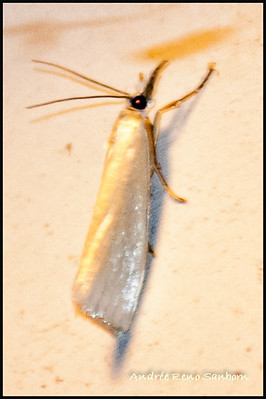snowy urola moth
(Urola nivalis)
Conservation • Description • Habitat • Ecology • Distribution • Taxonomy
|
||||||||
| Hodges # | 5464 |
|||||||
Conservation Status |
||||||||
| IUCN Red List | not listed |
|||||||
| NatureServe | NNR - Unranked SNR - Unranked |
|||||||
| Minnesota | not listed |
|||||||
Description |
||
Snowy urola moth is a common, small, crambid snout moth. It occurs in the United States and southern Canada east of the Great Plains. It is the most common of the 45 species in the tribe Argyriini. It is common in Minnesota. The larvae feed on grasses. Adults are found in grassy woodlands and old fields. They are active from May to September in the south, mid-June to late July in Minnesota. Adults are narrow bodied and ½″ (12 mm) in length. They have a ⅝″ to ⅞″ (15 to 23 mm) wingspan. The head is brown on the sides, white above. The antennae are brown. They are held back over the body when at rest. There are two large compound eyes on the side of the head and a single, well-developed, simple eye (ocellus) near the top edge of each compound eye. The finger-like sensory organs (palps) attached to the mouth are moderately long and densely hairy. They are projected forward, appearing like a fuzzy snout. The thorax is white with a single, light orangish brown or buff, longitudinal stripe above. The forewings are silvery white with a satin sheen. They are held tent-like over the body when at rest. There is a small black dot on the inner margin of each wing. The terminal line is represented by a series of black dashes. The fringe is light orangish brown or buff. It is usually darker at the base, appearing to give the wings a thin dark line on the outer margin. The hindwings are white, translucent, and unmarked. The front legs are brown. The middle and hind legs are white. |
||
Size |
||
Total length: ½″ (12 mm) Wingspan: ⅝″ to ⅞″ (15 to 23 mm) |
||
Similar Species |
||
Habitat |
||
Grassy woodlands and old fields |
||
Ecology |
||
Season |
||
Two generations per year: May to September in the south, mid-June to late July in Minnesota. |
||
Behavior |
||
The forewings are held tent-like over the body when at rest. |
||
Life Cycle |
||
|
||
Larva Food |
||
Grasses |
||
Adult Food |
||
|
||
Distribution |
||||
|
Sources |
|||
| 11/15/2023 | ||||
Occurrence |
||||
Common |
||||
Taxonomy |
|||
Order |
Lepidoptera (Butterflies and Moths) | ||
Superfamily |
Pyraloidea (Pyralid and Crambid Snout Moths) | ||
Family |
Crambidae (Crambid Snout Moths) | ||
Subfamily |
Crambinae (Grass-veneers and Allies) | ||
Tribe |
Argyriini | ||
Genus |
Urola | ||
Synonyms |
|||
Geometra argentata Phalaena nivalis Urola microchrysella |
|||
Common Names |
|||
snowy urola moth |
|||
Glossary
Palp
Short for pedipalp. A segmented, finger-like process of an arthropod; one is attached to each maxilla and two are attached to the labium. They function as sense organs in spiders and insects, and as weapons in scorpions. Plural: palpi or palps.
Visitor Photos |
|||||
Share your photo of this insect. |
|||||
| This button not working for you? Simply email us at info@MinnesotaSeasons.com. Attach one or more photos and, if you like, a caption. |
|||||
Babette Kis |
|||||
Snowy urola moth, Urola nivalis Snowy urola, Urola nivalis, Barnes Prairie Remnant, Racine Co., WI. Photo was taken on July 3, 2022. I've seen this moth at prairies, weedy fields, and grassy roadsides. |
 |
||||
MinnesotaSeasons.com Photos |
|||||
|
|||||

Visitor Videos |
|||
Share your video of this insect. |
|||
| This button not working for you? Simply email us at info@MinnesotaSeasons.com. Attach a video, a YouTube link, or a cloud storage link. |
|||
Other Videos |
|||
| Florida Man Encounters Snowy Urola Moth - Insect Freetime Treeclimbv |
|||
About
Dec 23, 2022 |
|||


Created: 11/15/2023
Last Updated:



